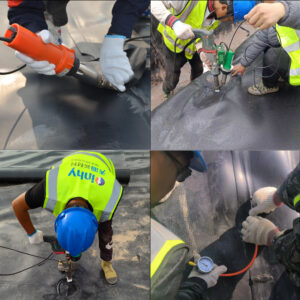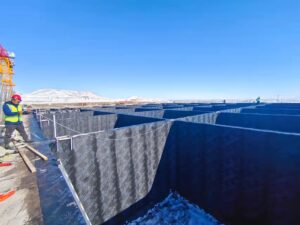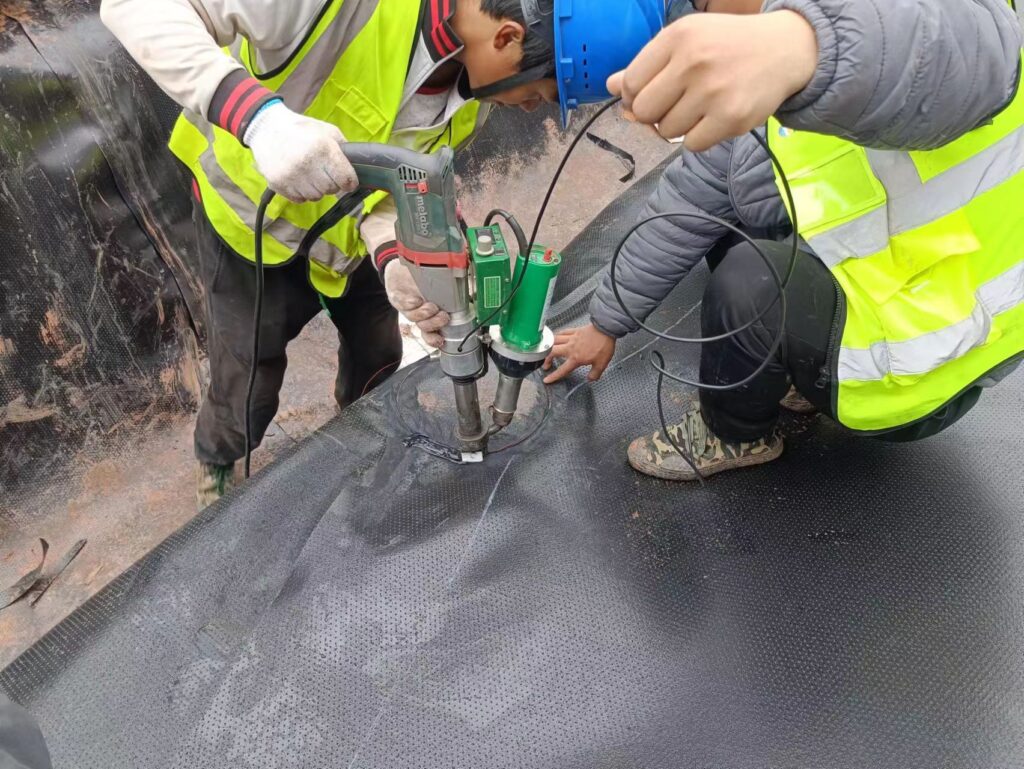Geomembrane welding process
Geomembrane welding is a crucial process used in the installation and construction of geosynthetic liners for various applications such as landfill liners, mining ponds, agricultural reservoirs, and other environmental containment systems.
Geomembranes are impermeable sheets made from materials like high-density polyethylene (HDPE), polyvinyl chloride (PVC), and ethylene propylene diene monomer (EPDM).
Welding ensures that these sheets are joined together to create a continuous and leak-proof barrier.
There are several methods of geomembrane welding, and two common techniques are:
Hot Wedge Welding:
This method utilizes a hot wedge to melt and fuse the geomembrane sheets together.
The process involves a machine with a heated wedge, which is pressed between the two geomembrane sheets to be joined.
The heat softens the geomembrane material, and pressure is applied to create a secure and durable weld.
Extrusion Welding:
Extrusion welding involves the use of a specialized extruder machine that melts the geomembrane material and extrudes it into a molten state.
The molten material is then applied to the seam between two geomembrane sheets, creating a strong bond as it solidifies.
This method is particularly effective for welding seams on vertical surfaces or in challenging conditions.
In both methods, it’s crucial to follow specific procedures to ensure a proper weld and maintain the integrity of the geomembrane liner. Here are some general guidelines for geomembrane welding:
Surface Preparation:
The surfaces to be welded must be clean, dry, and free from any contaminants that could affect the welding process or compromise the weld quality.
Temperature and Speed Control:
The welding machine should be set to the appropriate temperature for the geomembrane material being used.
Welding speed is also important, and it should be adjusted according to the material and environmental conditions.
Welding Technique:
Welding should be done systematically, with attention to detail, to ensure a consistent and reliable seam.
Proper overlap and pressure are critical factors in creating a strong and watertight bond.
Quality Control:
Regular testing, such as visual inspections and destructive testing of sample welds, should be performed to verify the quality of the welds.
The specific welding method and equipment used may vary depending on the type of geomembrane material, project requirements, and site conditions.
It’s essential to follow the manufacturer’s guidelines and industry standards for geomembrane welding to ensure the effectiveness and longevity of the containment system.

What are the geomembrane welding tools?
Geomembrane welding tools are specialized equipment designed for joining and sealing geomembrane sheets during installation. These tools ensure the creation of strong, reliable seams that form impermeable barriers in various applications such as environmental containment, landfill liners, reservoirs, and pond liners. The specific tools required can vary depending on the welding technique employed. Here are some common geomembrane welding tools:
Wedge Welders (Hot Wedge Welding):
Hot Wedge Welding Machine: This machine has a heated wedge that is used to melt and fuse the geomembrane material. It is equipped with controls for temperature and speed.
Pressure Rollers: These are used to apply pressure to the welded seam, ensuring a secure bond.
Extrusion Welders (Extrusion Welding):
Extruder Machine: An extrusion welder has a heated extrusion nozzle that melts the geomembrane material. The molten material is extruded onto the seam, creating a strong bond.
Welding Rod Feeder: This device feeds the welding rod into the extruder, ensuring a continuous supply of material for the welding process.
Testing and Quality Control Tools:
Testing Equipment: This may include tools for visual inspections, as well as non-destructive and destructive testing methods to assess the quality of the welds.
Spark Tester: Used to detect flaws or voids in the welded seams by applying a high voltage to the geomembrane surface.
Accessories:
Welding Rods: Depending on the welding method, specific welding rods made from the same material as the geomembrane are used to enhance the bond.
Seam Rollers: Used to press and smooth the welded seams for better adhesion.
Cleaning Tools: Brushes or other tools for cleaning and preparing the geomembrane surfaces before welding.
Personal Protective Equipment (PPE):
Safety Gear: Welders should use appropriate PPE, including safety glasses, gloves, and, if necessary, respiratory protection.
Geosynthetic Test Kits:
Test Kits: These may include equipment to conduct various tests on geomembrane seams, such as peel tests, shear tests, and seam strength tests.
It’s important to note that the specific tools and equipment required can vary based on the type of geomembrane material being used, the welding method, and the project’s specific requirements. Additionally, following manufacturer guidelines and industry standards for equipment calibration and maintenance is crucial to ensure the quality of geomembrane welding.

Why are geomembranes welded?
Geomembranes are welded to create strong and impermeable seams between adjacent sheets of geomembrane material. The welding process is a critical step in the installation of geomembrane liners, and it serves several important purposes:
Containment and Leak Prevention:
The primary purpose of geomembranes is to provide containment and prevent the leakage of liquids or gases. Welding creates a continuous and watertight seal, ensuring that no substances can pass through the geomembrane barrier.
Environmental Protection:
Geomembranes are often used in environmental applications, such as landfill liners, pond liners, and reservoir liners. Welding ensures that these containment systems effectively protect the surrounding environment from potential contaminants, preventing pollution of soil and groundwater.
Structural Integrity:
Welding geomembrane sheets together enhances the structural integrity of the liner. A properly welded seam forms a strong bond, reducing the risk of seam failure and providing stability to the overall geomembrane system.
Long-Term Durability:
Welded seams contribute to the long-term durability of geomembrane liners. A well-executed weld can withstand environmental stresses, including temperature variations, settlement, and other factors, ensuring the liner’s effectiveness over an extended period.
Seam Consistency:
Welding allows for the creation of consistent and uniform seams. Uniformity is crucial for ensuring that the geomembrane liner performs as intended, without weak points or areas susceptible to failure.
Customization and Installation Flexibility:
Geomembranes are available in large rolls or sheets, and welding enables the customization of liners to fit the specific dimensions and contours of a given site. This flexibility allows for efficient and precise installation.
Seam Testing and Quality Assurance:
Welding provides an opportunity for quality control and testing. After welding, various tests, such as visual inspections, spark testing, and destructive testing, can be performed to ensure the integrity of the seam and the overall geomembrane liner.
Cost-Effective Installation:
Welding eliminates the need for additional mechanical fasteners or adhesives, making the installation process more cost-effective. It also reduces the likelihood of installation errors associated with alternative joining methods.
The choice of welding method (e.g., hot wedge welding, extrusion welding) depends on factors such as the type of geomembrane material, project specifications, and site conditions. Overall, geomembrane welding plays a crucial role in creating reliable containment systems that protect the environment and ensure the integrity of various engineering applications.
How to weld geomembrane to save the most money?
Saving money on geomembrane welding involves a combination of efficient practices, proper planning, and adherence to industry standards. Here are some tips to help you weld geomembranes while optimizing costs:
Accurate Project Planning:
Thoroughly assess the project requirements, including dimensions, site conditions, and environmental considerations. Accurate planning helps minimize material waste and ensures that the geomembrane sheets are customized to fit the site precisely.
Select Cost-Effective Geomembrane Material:
Choose geomembrane materials that meet project specifications but are cost-effective. Different materials, such as HDPE, PVC, and EPDM, have varying costs, so select the one that balances performance with budget constraints.
Optimize Welding Techniques:
Choose the welding method that suits the project requirements while being cost-effective. For instance, hot wedge welding and extrusion welding are common techniques, but the specific choice may depend on factors such as material type, project complexity, and welding speed.
Minimize Material Waste:
Carefully measure and cut geomembrane sheets to minimize waste. This is particularly important when dealing with custom shapes or irregular site layouts. Reducing material waste contributes directly to cost savings.
Efficient Welding Equipment:
Invest in reliable but cost-effective welding equipment. Regularly maintain and calibrate the equipment to ensure optimal performance, preventing costly downtime and repairs.
Skilled and Efficient Workforce:
Ensure that the welding team is well-trained and skilled in geomembrane welding techniques. Proficient workers can achieve better results in less time, reducing labor costs and improving overall efficiency.
Quality Assurance and Testing:
Implement a robust quality control process, including visual inspections and testing of welded seams. Detecting issues early on can prevent the need for costly rework or repairs after installation.
Proactive Safety Measures:
Prioritize safety to avoid accidents or injuries that could lead to additional costs. Adequate safety measures also contribute to an efficient workflow.
Consider Prefabrication:
In some cases, prefabricating geomembrane panels in a controlled environment can improve efficiency and reduce on-site labor costs. Prefabrication allows for precise welding conditions and minimizes weather-related disruptions.
Explore Bulk Purchase Options:
If the project involves a significant quantity of geomembrane material, inquire about bulk purchase discounts or negotiate favorable terms with suppliers. Buying in bulk can result in cost savings.
Efficient Site Logistics:
Plan the delivery and handling of geomembrane materials efficiently to minimize transportation costs and on-site disruptions.
Remember that the specific cost-saving measures may vary depending on the project’s unique characteristics and requirements. It’s essential to balance cost considerations with the need for a high-quality, reliable geomembrane installation that meets industry standards and regulatory requirements.


